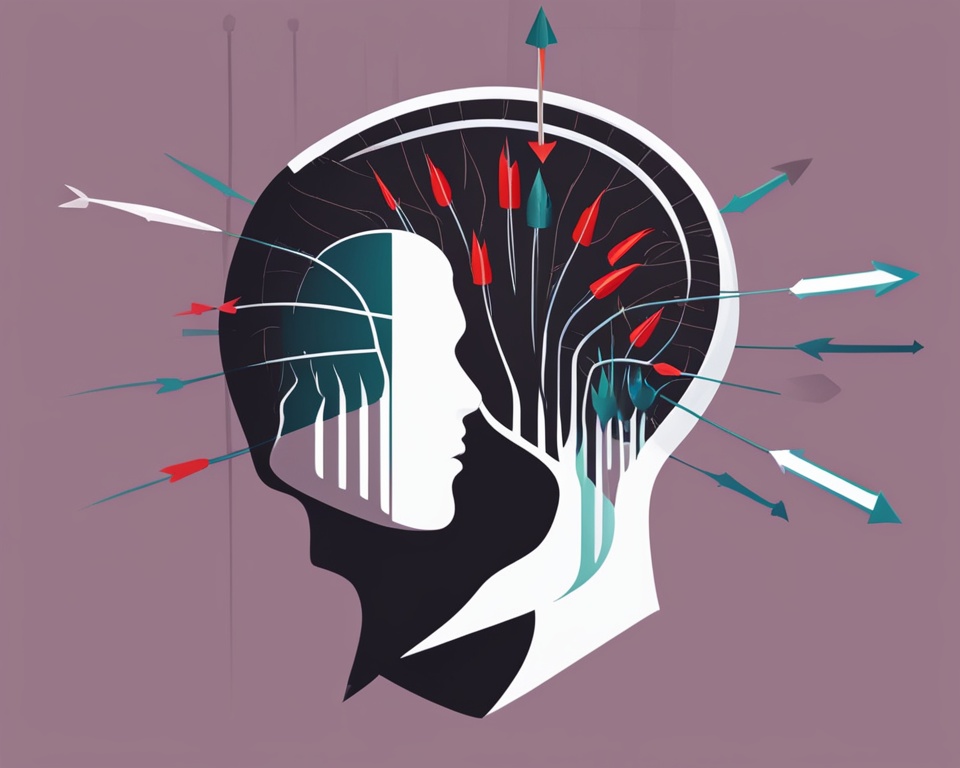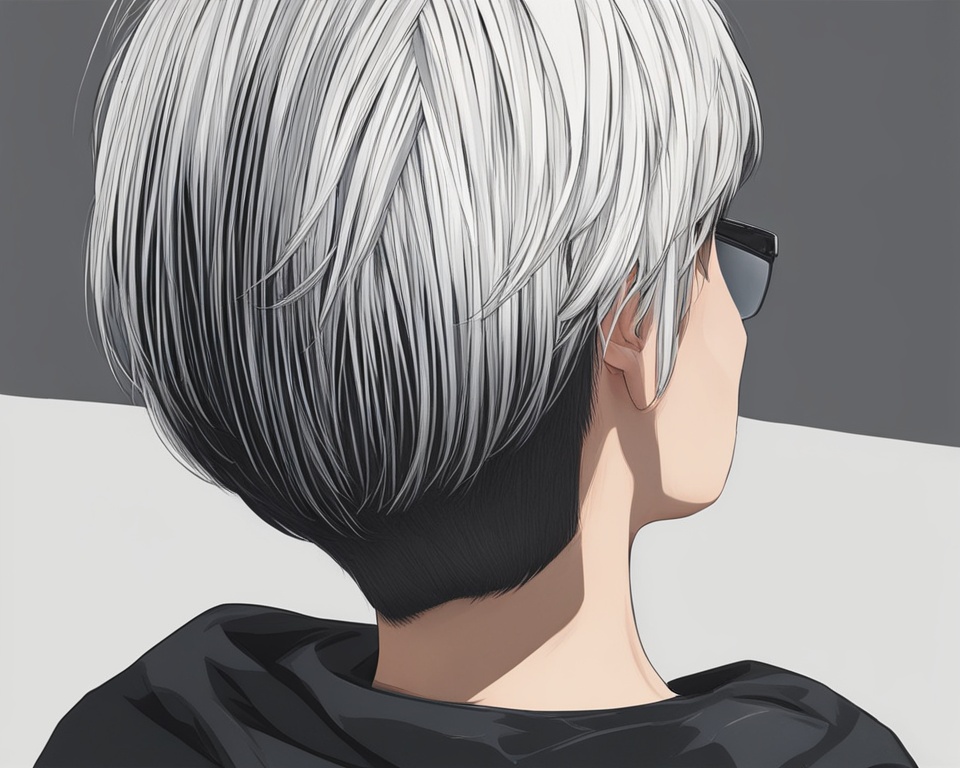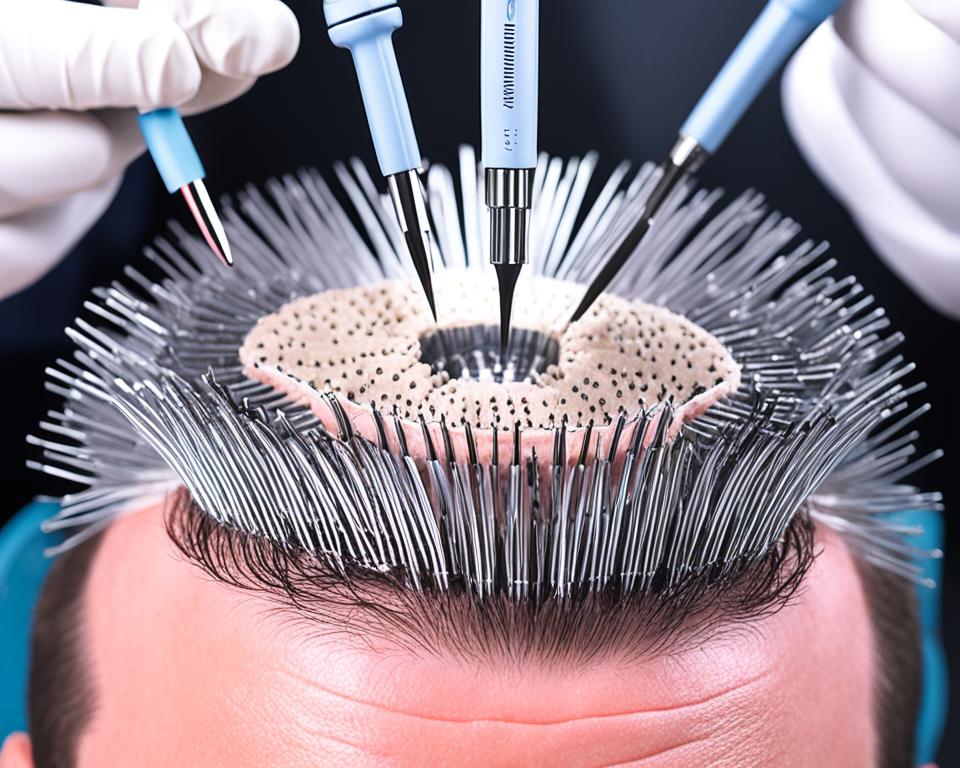Finding out your hair is thinning at the crown might come as a shock. It’s not always the first place we look. But, to deal with this issue, it’s key to know what causes it. Dr. Kimberly Lee and Dr. Deanne Mraz Robinson talk a lot about the hair growth cycle. They point out things like DHT can mess it up.
Kerry Yates, another expert, believes in a personalized plan. She thinks care for your scalp, being gentle with your hair, and the right diet can really help. By combining these approaches, you might start to feel better about your hair. A healthy head of hair could be in your future.
Key Takeaways
- Understanding the commonality of crown hair loss in both men and women.
- Identifying hormonal shifts and lifestyle factors as key influences on hair thinning.
- Recognizing the impact of DHT on the hair growth cycle and seeking solutions to mitigate its effects.
- Implementing gentle hair care and scalp health as preventative measures against hair loss.
- Adapting diet and lifestyle to support hair regrowth and prevent future thinning.
Understanding Hair Loss at the Crown
Crown hair thinning can easily slip by unnoticed. It’s called silent progression because it starts at the top. Figuring out if your crown is thinning is hard at first. You might not see it until you try a new style and notice the thinning.
At first, some might think it’s just hair shedding. But if you see a lot of hair loss at the crown, you should look closer. It’s important to find out why it’s happening. This helps you take steps to stop more hair from falling out.
| Stages of Hair Thinning | Description | Common Signs |
|---|---|---|
| Early Stage | Slight thinning that often goes unnoticed | More scalp visible, especially when styling hair |
| Progressive Stage | Increased hair loss, becoming more noticeable | Hair part widens, thinning becomes evident |
| Advanced Stage | Significant loss leading to bald patches | Visible bald spots or very thin crown |
Crown hair thinning is hard to catch early. But recognizing it soon is key. Doing so can make a big difference. You can keep more of your hair and keep your scalp healthy.
Exploring Causes of Thinning Crown in Men and Women
Thin hair at the crown is often caused by many factors. This includes hormones, health issues, and how we live. Knowing these helps to prevent and manage this problem.
Hormonal Influences and Androgenic Alopecia
DHT has a big role in making the crown hair thin. This hormone shortens the hair growth phase, making hair weaker and thinner. For many, changes in their hormones cause this hair loss.
Medical Conditions and Medication Effects
Conditions like PCOS and changes after pregnancy can make hair thin. Also, some drugs can cause hair loss. It’s important to talk to doctors about your medication to know the risks.
Lifestyle and Hairstyling Habits
Wearing tight hairstyles can lead to hair loss. This is called traction alopecia. Using too much heat and products like dry shampoo can also damage hair. This makes hair loss more likely, especially without the right genes.

| Cause of Hair Loss | Type of Alopecia | Preventability |
|---|---|---|
| DHT and Hormonal Imbalance | Androgenetic Alopecia | Moderately Preventable |
| PCOS, Post-Partum Hormonal Changes | Androgenetic Alopecia | Possibly Preventable |
| Tight Hairstyling | Hairstyle-Induced Alopecia | Highly Preventable |
Learning about these causes can help you take better care of your hair. This can keep your hair healthy and reduce thinning problems.
Thinning Hair at Crown: What Hormones are to Blame?
Understanding how hormones affect hair health is key to dealing with hormonal hair loss at the crown. Too much Dihydrotestosterone (DHT) is a major issue, causing hair to thin and fall out. This happens more with PCOS, a condition that raises androgen levels, making it hard for hair to grow.
After giving birth, many women face postpartum thinning. This is often temporary but causes big stress. Hormone changes then make the hair lose volume and become unhealthy.
Hormonal changes can disrupt the hair’s natural growth cycle. DHT, an androgen, plays a big role. It makes hair fall out more and grow less, leading to thinning, especially at the crown.
Dealing with hormonal issues causing thinning hair is not easy. But, managing these imbalances can help keep or grow more hair. This can be through doctor help or changing your lifestyle to balance hormones. Being proactive in keeping hormones in check is the best way to fight crown thinning.
Early Signs of Hair Thinning at the Crown
Noticing thinning hair at the crown often starts subtly but becomes clear over time. Seeing these early signs is key to catching hair loss early. This allows for getting help when needed.
Widening Hair Part and Visible Scalp
One big sign of thinning hair is a widening part. As hair starts to thin, you see the scalp more. This can make people look closer at their hair and take action sooner.
Changes in Hair Texture and Strength
Hair can change in texture and weaken before you see it thinning. It might feel finer and lose some of its strength and fullness. This change may be especially worrisome during grooming.
Recognizing Increased Hair Shedding
Noticing more hair falling out can be a warning sign of ongoing hair loss. Understanding the difference between regular shedding and excessive loss that needs attention is vital.
Signs of thinning hair can be worrying and push people to see experts. These professionals can help understand scalp and hair health better.

| Sign | Description | Common Causes |
|---|---|---|
| Widening hair part | Increasing visibility of the scalp along the hairline | Genetics, hormonal changes |
| Texture changes | Hair feels thinner and weaker | Poor nutrition, stress |
| Increased shedding | Higher than usual hair fall rate | Stress, alopecia conditions |
Noticing and addressing early signs can greatly impact managing hair loss. This is true for dealing with hair part widening and overall crown thinning.
The Impact of Diet and Nutrition on Hair Health
Your diet plays a big role in how healthy your hair is. Both nutrition experts and hair specialists agree on this. They explain that what you eat affects how your hair grows. This shows why getting the right hair growth nutrients is so important. Not getting enough of these nutrients can lead to dietary hair loss>. But, it’s a problem you can solve by balancing your nutrients correctly.
Vitamin deficiencies can do a lot of harm, especially if you lack iron, zinc, or folic acid. These vitamins are key for making and keeping your hair healthy. Without them, your hair might start to thin. A diet full of these vitamins, on the other hand, helps your hair grow strong. It makes your hair’s foundation, from the root to the tip, solid.
Now, let’s look at some important nutrients and what they do for your hair:
| Nutrient | Benefits | Food Sources |
|---|---|---|
| Iron | Facilitates hair growth and repair | Spinach, red meat, lentils |
| Zinc | Prevents hair follicle regression | Pumpkin seeds, oysters, beef |
| Folic Acid | Enhances follicle development | Avocado, fortified cereals, oranges |
If you cut down too much on food, you might lose these important hair growth nutrients. This can make your hair fall out more and get thinner. So, it’s best to eat a variety of foods to keep your hair strong. Make sure your diet is full of everything your hair needs to grow and stay full.
Preventative Strategies to Combat Crown Thinning
To prevent hair thinning, care for your scalp and change some habits. It’s crucial to use methods that boost scalp and hair health. This way, you can fight off alopecia due to stress and other reasons.
Effective Hair Care and Gentle Styling
A good scalp care plan can stop hair from getting too thin. Here are some key steps:
- Avoid harsh chemicals and heat styling tools that can weaken hair structure.
- Choosing looser hairstyles that do not pull tightly on the roots.
- Patting hair dry gently instead of rubbing vigorously when wet.
The Role of Scalp Health in Hair Growth
Keeping your scalp in top shape is vital for growing healthy hair. To do this, ensure your scalp is clean and well-fed:
- Use sulfate-free shampoos that cleanse without stripping natural oils.
- Incorporate exfoliating treatments to remove dead skin cells and promote circulation.
- Regularly massage the scalp to enhance blood flow and nutrient delivery to hair follicles.
Stress Management and Hair Preservation
Dealing with stress and alopecia is key for saving your hair. Ways to reduce stress and help your hair include:
- Getting into physical activities to lower stress and feel better.
- Practicing meditation and yoga to relax and balance stress hormones.
- Eating a well-rounded diet full of vitamins and minerals that your hair craves.

| Supplement | Purpose | Recommended Amount |
|---|---|---|
| Biotin | Strengthens hair | 30 mcg daily |
| Zinc | Supports hair tissue growth and repair | 11 mg daily |
| Iron | Prevents hair loss associated with anemia | 18 mg daily |
| Magnesium | Activates enzymes that aid in hair growth | 400 mg daily |
| Ashwagandha | Reduces stress and cortisol levels | 300 mg daily |
Non-Surgical Treatments for Hair Regrowth
Looking into non-surgical methods is key for first signs of thinning. Minoxidil is a top choice, proven to help hair growth. It combats the main cause of hair loss by stopping DHT, which makes hair follicles smaller.

Hair loss shampoos are a big help in daily hair care. They cleanse and include important amino acids and nutrients. These strengthen hair from the roots. Let’s see how their ingredients and benefits differ.
| Product Type | Main Ingredients | Expected Benefits |
|---|---|---|
| Minoxidil Solutions | Topical Minoxidil (5% concentration) | Revitalizes hair follicles, increasing the hair density |
| Hair Loss Shampoos | Amino acids, herbal extracts, vitamins | Supports hair strength, adds volume, and reduces breakage |
| DHT Blocker Supplements | Natural DHT blocking compounds like saw palmetto | Slows hair loss by inhibiting DHT production |
Minoxidil goes right on the scalp. DHT blockers can be pills or in hair products. They work together to battle early hair loss.
Using these treatments regularly can make a big difference. Better hair and overall hair health are the goals. Always use products as directed and talk to a doctor for a plan that’s right for you.
Surgical Options and Advanced Hair Restoration Techniques
In today’s world, some people struggle with losing hair. Luckily, there are advanced treatments that can truly help. The hair transplant procedure and PRP benefits are leading the way. They are big steps forward in hair restoration advancements.
Understanding Hair Transplant Surgery
The process of a hair transplant is a milestone in making us look better. It moves hair from thick to thin areas on the scalp. This makes hair grow again permanently where it was lost. It’s a key method in the field of hair restoration advancements.
PRP Therapy and Its Effectiveness
PRP therapy is a less scary option that works well. A doctor injects your own platelets into your scalp. This makes hair grow back stronger and thicker. The PRP benefits also help heal your scalp faster.
Innovations in Hair Loss Treatment
Now, we also have stem cell therapy and exosomes. They’re gentle but powerful ways to fight hair loss. These are part of the bigger hair restoration advancements. Scientists are looking into using them more often.
Take a look at how these new methods compare to the old ones:
| Technique | Description | Duration of Effectiveness |
|---|---|---|
| Hair Transplant | Moving hair to fill in bald spots. | Permanent |
| PRP Therapy | Using platelets to create new hair. | Lasts 1-2 years |
| Stem Cell Therapy | Putting in stem cells to grow hair. | Can be long-term |

These treatments bring back hope and self-esteem for people with serious hair loss. They show how much progress we’ve made in hair care technology.
Conclusion
Dealing with thinning hair, especially on the crown, needs attention and a full plan. Recognizing early signs is key. This allows for the best steps to stop more hair from falling out. To fight hair loss, it’s important to know what might be causing it. Then, you can start a plan that’s right for you. Changing your diet, using gentle hair products, and managing stress are good steps.
If you want to make your hair fuller again, you have many options that don’t need surgery. Products like Minoxidil, special shampoos, and vitamins are top choices. But if these don’t work, surgery and high-tech hair treatments can help. You can choose from classic hair transplants to new PRP therapy, depending on your needs.
Now, we have more ways to handle hair loss than ever before. With new findings and treatments, it’s possible to get back lost hair and feel good again. In the future, solutions for thinning at the top of the head will keep getting better. This shows why it’s great to work with doctors who are always looking for new ways to help.


Reply